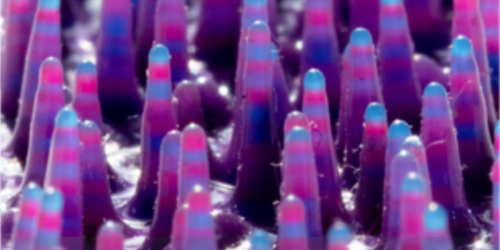Drip Physics Produces Flexible Stalactite-Like Surface
If you’ve ever painted a ceiling and had paint drops rain down on your head, you can blame the Rayleigh-Taylor instability. This effect occurs when the downward force of gravity overcomes the surface tension of the paint film and causes the formation of droplets. Researchers have now explored this behavior using a liquid polymer that solidifies in about ten minutes. When applied repeatedly to an inverted surface, the dripping polymer hardens into stalactite-like structures, which the team calls “flexicles” [1]. Owing to their varied lengths and bending properties, the flexicles might serve as a force sensor in soft-robotics applications.
Pierre-Thomas Brun from Princeton University and his colleagues accidentally discovered the flexicles while studying pattern formation in soft materials. They originally started with single layers of the polymer and observed the hardened droplets naturally forming on the surface [2]. “We immediately noticed their resemblance with icicles and stalactites and were drawn to rationalize the physics at play,” Brun says. They have now explored what happens when multiple layers of polymer are added, with sufficient time for hardening between coats. They found that the polymer preferentially drains to the tips of already formed flexicles, causing them to grow longer by about 1 mm for each added layer.
The result is a complex pattern of long, rubbery appendages with variable lengths. Brun and his colleagues imagine using the flexicles in a force sensor. The idea would be to cover a surface with flexicles and measure how many of them are bent or deformed by an object pressing against the surface. Such a sensor could be useful in soft robotics that work without hard electronic parts, Brun says.
–Michael Schirber
Michael Schirber is a Corresponding Editor for Physics Magazine based in Lyon, France.
References
- B. Venkateswaran et al., “Stacked Rayleigh-Taylor instabilities grow drops into soft stalactitelike structures,” Phys. Rev. Lett. 133, 198201 (2024).
- J. Marthelot et al., “Designing soft materials with interfacial instabilities in liquid films,” Nat. Commun. 9, 4477 (2018).




